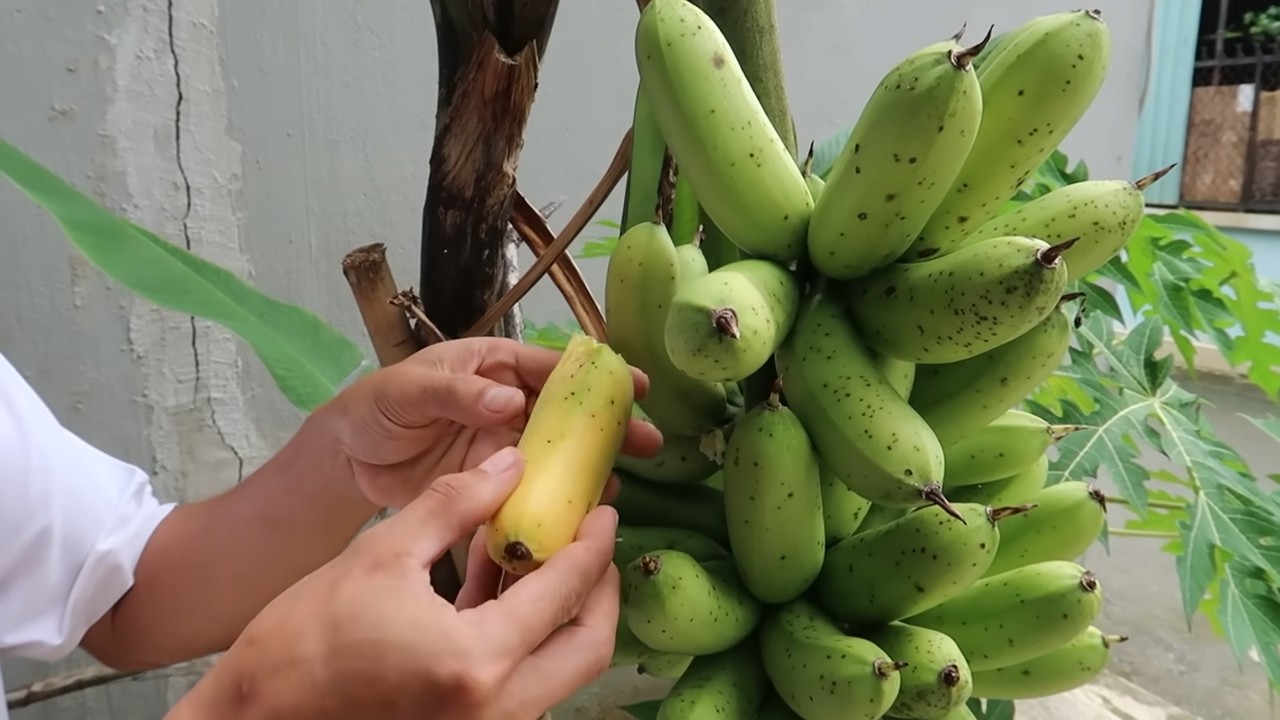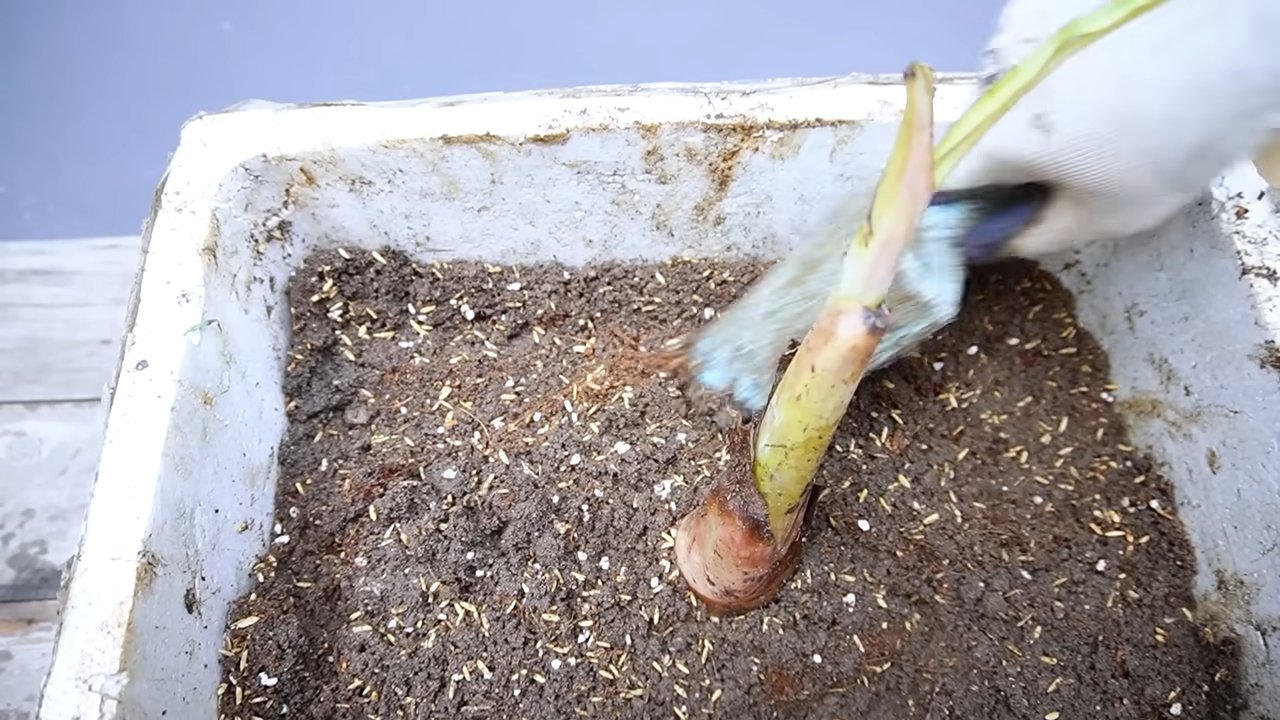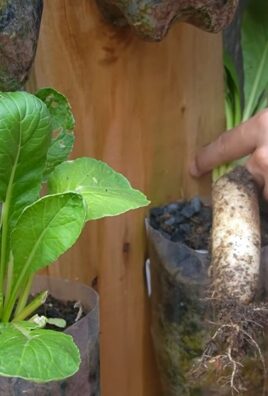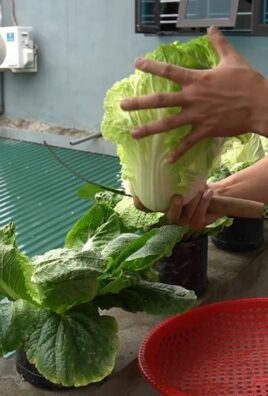Growing Bananas at Home might seem like a tropical dream reserved for sun-drenched plantations, but I’m here to tell you it’s entirely possible to cultivate your own banana bounty, even if you don’t live in the tropics! Imagine plucking a perfectly ripe, homegrown banana right from your backyard – the taste is simply unparalleled.
Bananas have a rich history, dating back thousands of years in Southeast Asia. They’ve been a staple food source and a symbol of prosperity in many cultures. While traditionally grown in warmer climates, innovative gardening techniques now allow us to enjoy this delicious fruit in a wider range of environments.
Why should you try growing bananas at home? Well, store-bought bananas are often picked green and ripened artificially, sacrificing some of their natural sweetness and flavor. Plus, think of the satisfaction of nurturing a plant from a small shoot to a fruit-bearing beauty! This DIY guide will provide you with simple, effective tricks and hacks to successfully grow bananas, regardless of your gardening experience. We’ll cover everything from choosing the right variety and preparing the soil to protecting your plant from pests and diseases. Get ready to embark on a rewarding gardening adventure and enjoy the sweet taste of success!

Growing Bananas at Home: A Tropical Treat You Can Cultivate Yourself!
Okay, so you want to grow bananas at home? Awesome! It might seem like a tropical dream reserved for equatorial climates, but with a little know-how, you can absolutely cultivate these delicious fruits in your own backyard (or even indoors!). I’m going to walk you through everything you need to know, from choosing the right variety to harvesting your very own homegrown bananas. Let’s get started!
Choosing the Right Banana Variety
This is probably the most crucial step. Not all banana varieties are created equal, especially when it comes to growing them outside of their ideal tropical environment. You need to consider your climate, the available space, and your personal taste preferences. Here’s a breakdown:
* Cold Hardiness: Some varieties are more tolerant of cooler temperatures than others. Look for names like ‘Orinoco’, ‘Rajapuri’, or ‘Ice Cream’ (also known as ‘Blue Java’). These can handle brief dips into cooler temperatures better than, say, a ‘Cavendish’.
* Size: Banana plants can range from dwarf varieties that stay under 6 feet tall to giants reaching 20 feet or more. Consider your space! Dwarf varieties like ‘Dwarf Cavendish’ or ‘Truly Tiny’ are great for containers or smaller gardens.
* Taste: Of course, you want bananas you’ll enjoy eating! ‘Cavendish’ is the standard grocery store banana, but there are so many other flavors to explore. ‘Ice Cream’ bananas have a vanilla-like flavor, ‘Rajapuri’ is sweet and tangy, and ‘Orinoco’ is known for its slightly tart taste.
* Disease Resistance: Some varieties are more resistant to common banana diseases like Panama disease or black Sigatoka. Research the disease resistance of the varieties you’re considering, especially if you live in an area where these diseases are prevalent.
My Recommendation: If you’re a beginner, I’d suggest starting with a ‘Dwarf Cavendish’ or ‘Rajapuri’. They’re relatively easy to grow, cold-hardy, and produce delicious fruit.
Preparing for Planting
Before you even think about putting your banana plant in the ground (or pot), you need to get everything ready. This includes choosing the right location, preparing the soil, and gathering your supplies.
* Sunlight: Bananas are sun-worshippers! They need at least 6-8 hours of direct sunlight per day. Choose a location that gets plenty of sun throughout the day.
* Soil: Bananas thrive in well-draining, fertile soil. They prefer slightly acidic soil with a pH between 6.0 and 6.5.
* Water: Bananas need consistent moisture, especially during the growing season. Make sure your chosen location has good drainage to prevent root rot.
* Wind Protection: Banana leaves are large and can be easily damaged by strong winds. Choose a location that is sheltered from strong winds, or consider building a windbreak.
* Space: Remember how big your chosen variety will get! Give it plenty of room to grow, both above and below ground.
Supplies You’ll Need:
* Banana pup or rhizome (the underground stem)
* Gardening gloves
* Shovel or trowel
* Well-draining potting mix (if planting in a container)
* Compost or other organic matter
* Watering can or hose
* Fertilizer (balanced fertilizer with micronutrients)
* Mulch (optional)
Planting Your Banana Plant
Okay, now for the fun part! Planting your banana plant is relatively straightforward, but it’s important to follow these steps carefully to ensure success.
1. Prepare the Planting Hole: Dig a hole that is twice as wide and as deep as the root ball of your banana pup or rhizome.
2. Amend the Soil: Mix the soil you removed from the hole with compost or other organic matter to improve drainage and fertility.
3. Plant the Banana Pup: Carefully place the banana pup in the hole, making sure the top of the root ball is level with the surrounding soil.
4. Backfill the Hole: Fill the hole with the amended soil, gently tamping it down to remove any air pockets.
5. Water Thoroughly: Water the newly planted banana plant thoroughly to help settle the soil and encourage root growth.
6. Mulch (Optional): Apply a layer of mulch around the base of the plant to help retain moisture and suppress weeds.
Container Planting:
If you’re planting in a container, choose a large pot with drainage holes. Fill the pot with well-draining potting mix and follow the same steps as above. Make sure the container is large enough to accommodate the plant’s mature size.
Caring for Your Banana Plant
Once your banana plant is planted, it’s important to provide it with the proper care to ensure healthy growth and fruit production.
* Watering: Water your banana plant regularly, especially during the growing season. Keep the soil consistently moist, but not waterlogged. Reduce watering during the winter months.
* Fertilizing: Bananas are heavy feeders and need regular fertilization. Use a balanced fertilizer with micronutrients every 2-3 months during the growing season. Follow the instructions on the fertilizer label.
* Pruning: Remove any dead or damaged leaves regularly. You can also remove suckers (small shoots that grow from the base of the plant) to encourage the main plant to focus its energy on fruit production. However, leaving one or two suckers can help ensure a continuous supply of bananas in the future.
* Pest and Disease Control: Monitor your banana plant regularly for pests and diseases. Common pests include aphids, spider mites, and nematodes. Common diseases include Panama disease and black Sigatoka. Treat any infestations or infections promptly with appropriate pesticides or fungicides.
* Winter Protection: If you live in an area with cold winters, you’ll need to protect your banana plant from frost. You can wrap the trunk with burlap or blankets, or move the plant indoors if it’s in a container.
Flowering and Fruiting
After about 9-12 months, your banana plant should start to flower. The flower stalk will emerge from the center of the plant and produce a large, purple bud. As the bud opens, it will reveal rows of small, female flowers that will eventually develop into bananas.
* Supporting the Fruit Bunch: As the bananas grow, the fruit bunch can become quite heavy. You may need to support the bunch with a stake or rope to prevent it from breaking the plant.
* Removing the Male Bud: After the last row of female flowers has opened, you can remove the male bud (the tip of the flower stalk) to encourage the bananas to ripen faster.
Harvesting Your Bananas
Harvesting your bananas is the culmination of all your hard work! Here’s how to know when they’re ready:
* Appearance: The bananas will become plump and rounded, and the skin will turn from green to yellow.
* Touch: The bananas will feel slightly soft to the touch.
* Timing: It takes about 2-3 months for bananas to ripen after the flower stalk emerges.
Harvesting Steps:
1. Cut the Stalk: Use a sharp knife or machete to cut the banana stalk from the plant.
2. Handle with Care: Be careful not to bruise the bananas when handling them.
3. Ripen Indoors: Hang the banana stalk in a cool, dry place to ripen. You can also place individual bananas in a paper bag with an apple or banana to speed up the ripening process.
Post-Harvest Care
After you’ve harvested your bananas, the main plant will die back. However, the suckers that you left behind will continue to grow and produce more bananas in the future.
* Cut Down the Old Plant: Once the main plant has died back, cut it down to the ground.
* Fertilize the Suckers: Continue to fertilize the suckers to encourage healthy growth.
* Repeat the Process: In about 9-12 months, the suckers will flower and produce more bananas.
Troubleshooting
Even with the best care, you may encounter some problems when growing bananas. Here are some common issues and how to address them:
* Yellowing Leaves: This can be caused by a variety of factors, including nutrient deficiencies, overwatering, or underwatering. Check the soil moisture and nutrient levels and adjust your watering and fertilizing accordingly.
* Brown Spots on Leaves: This can be a sign of fungal disease. Treat with a fungicide.
* Slow Growth: This can be caused by insufficient sunlight, poor soil, or lack of fertilizer. Make sure your banana plant is getting enough sunlight, and amend the soil with compost or other organic matter. Fertilize regularly.
* No Fruit Production: This can be caused by a variety of factors,

Conclusion
So, there you have it! Growing bananas at home, while seemingly exotic, is entirely achievable with a little know-how and the right approach. This DIY trick isn’t just about saving money on store-bought bananas; it’s about experiencing the immense satisfaction of nurturing a plant from a small pup to a fruit-bearing beauty. It’s about connecting with nature, learning about plant life cycles, and enjoying the unparalleled flavor of a homegrown banana, ripened to perfection on your own plant.
But why is this DIY method a must-try? Beyond the obvious benefits of fresh, organic fruit, growing your own bananas offers a unique educational opportunity, especially for families with children. It teaches patience, responsibility, and an appreciation for the natural world. Plus, banana plants are stunning additions to any garden or indoor space, adding a touch of tropical flair and creating a conversation starter for guests.
Don’t be afraid to experiment with different banana varieties to find the one that best suits your climate and taste preferences. Dwarf Cavendish is a popular choice for indoor growing due to its manageable size, but other varieties like Goldfinger or Rajapuri might thrive in your outdoor garden, depending on your location. Consider the size of your container, the amount of sunlight your plant receives, and the frequency of watering to optimize your banana plant’s growth.
Variations and Suggestions:
* Companion Planting: Enhance your banana plant’s growth by planting companion plants like ginger, lemongrass, or even beans around its base. These plants can help improve soil health, deter pests, and even provide additional harvests.
* Fertilizer Options: While a balanced fertilizer is generally recommended, you can also explore organic options like compost tea or banana peel fertilizer to nourish your plant naturally.
* Pest Control: Regularly inspect your banana plant for pests like aphids or spider mites. Treat infestations promptly with insecticidal soap or neem oil.
* Winter Protection: If you live in a colder climate, consider bringing your banana plant indoors during the winter months or providing adequate protection from frost. Wrapping the trunk with burlap or using a greenhouse can help insulate the plant.
* Propagation: Once your banana plant matures, it will produce pups (small offshoots). These pups can be carefully separated from the mother plant and transplanted to create new banana plants, allowing you to expand your banana plantation.
We wholeheartedly encourage you to embark on this rewarding journey of growing bananas at home. It’s a project that offers both tangible rewards (delicious bananas!) and intangible benefits (a deeper connection with nature). The DIY trick we’ve outlined is a simple yet effective way to achieve success, even for beginner gardeners.
So, grab a banana pup, prepare your soil, and get ready to experience the joy of harvesting your own homegrown bananas. And most importantly, don’t forget to share your experiences with us! We’d love to hear about your successes, challenges, and any unique tips or tricks you discover along the way. Share your photos and stories on social media using [Your Hashtag Here] and let’s create a community of home banana growers! Happy growing!
Frequently Asked Questions (FAQ)
Q: What type of banana plant should I choose for growing at home?
A: The best type of banana plant for home growing depends on your climate and available space. Dwarf Cavendish is a popular choice for indoor growing due to its smaller size (typically reaching 6-10 feet tall). If you live in a warmer climate with a longer growing season, you might consider varieties like Goldfinger, Rajapuri, or Williams, which are known for their disease resistance and delicious fruit. Consider the mature height of the plant and ensure you have adequate space for it to thrive. Research the specific needs of each variety to determine which one is best suited for your environment.
Q: How much sunlight does a banana plant need?
A: Banana plants thrive in bright, indirect sunlight. Aim for at least 6-8 hours of sunlight per day. If growing indoors, place your banana plant near a sunny window, preferably one that faces south or east. If you don’t have enough natural light, you can supplement with grow lights. When growing outdoors, choose a location that receives ample sunlight but is also sheltered from strong winds, which can damage the leaves.
Q: What kind of soil is best for banana plants?
A: Banana plants prefer well-draining, fertile soil that is rich in organic matter. A slightly acidic to neutral pH (around 6.0-7.0) is ideal. You can create a suitable soil mix by combining equal parts of potting soil, compost, and perlite or sand. This mixture will provide good drainage and aeration while also supplying essential nutrients to the plant. Avoid heavy clay soils, as they can retain too much water and lead to root rot.
Q: How often should I water my banana plant?
A: Banana plants need consistent moisture, but it’s important to avoid overwatering. Water deeply when the top inch of soil feels dry to the touch. During the growing season (spring and summer), you may need to water more frequently than during the dormant season (fall and winter). Ensure that your pot has drainage holes to prevent water from accumulating at the bottom. Adjust your watering schedule based on the weather conditions and the plant’s growth stage.
Q: How do I fertilize my banana plant?
A: Banana plants are heavy feeders and require regular fertilization to support their growth and fruit production. Use a balanced fertilizer (e.g., 10-10-10 or 15-15-15) every 2-3 weeks during the growing season. You can also supplement with organic fertilizers like compost tea or banana peel fertilizer. Follow the instructions on the fertilizer packaging carefully to avoid over-fertilizing, which can damage the plant. Reduce or stop fertilizing during the dormant season.
Q: How long does it take for a banana plant to produce fruit?
A: It typically takes 9-15 months for a banana plant to produce fruit, depending on the variety, climate, and growing conditions. Once the plant reaches maturity, it will produce a flower stalk, which will eventually develop into a bunch of bananas. After the bananas are harvested, the mother plant will die, but it will produce pups (small offshoots) that can be used to grow new banana plants.
Q: How do I protect my banana plant from pests and diseases?
A: Regularly inspect your banana plant for pests like aphids, spider mites, and mealybugs. Treat infestations promptly with insecticidal soap or neem oil. Ensure good air circulation around the plant to prevent fungal diseases. Avoid overwatering, as this can create a favorable environment for root rot. If you notice any signs of disease, such as yellowing leaves or spots, remove the affected parts of the plant and treat with a fungicide if necessary.
Q: Can I grow bananas indoors in a container?
A: Yes, you can successfully grow bananas indoors in a container, especially with dwarf varieties like Dwarf Cavendish. Choose a large pot (at least 15-20 gallons) with drainage holes. Provide adequate sunlight, water, and fertilizer. Rotate the plant regularly to ensure even growth. Be prepared to repot the plant as it grows larger.
Q: What do I do with the banana plant after harvesting the fruit?
A: After harvesting the bananas, the mother plant will die. However, it will produce pups (small offshoots) that can be used to grow new banana plants. Carefully separate the pups from the mother plant and transplant them into individual pots. Alternatively, you can leave the pups attached to the mother plant to form a clump. Remove the dead mother plant to make room for the pups to grow.




Leave a Comment